A Week on the Trail With the “Disgusting Reporters” Covering Donald Trump
What it’s like to write about a candidate who hates you.
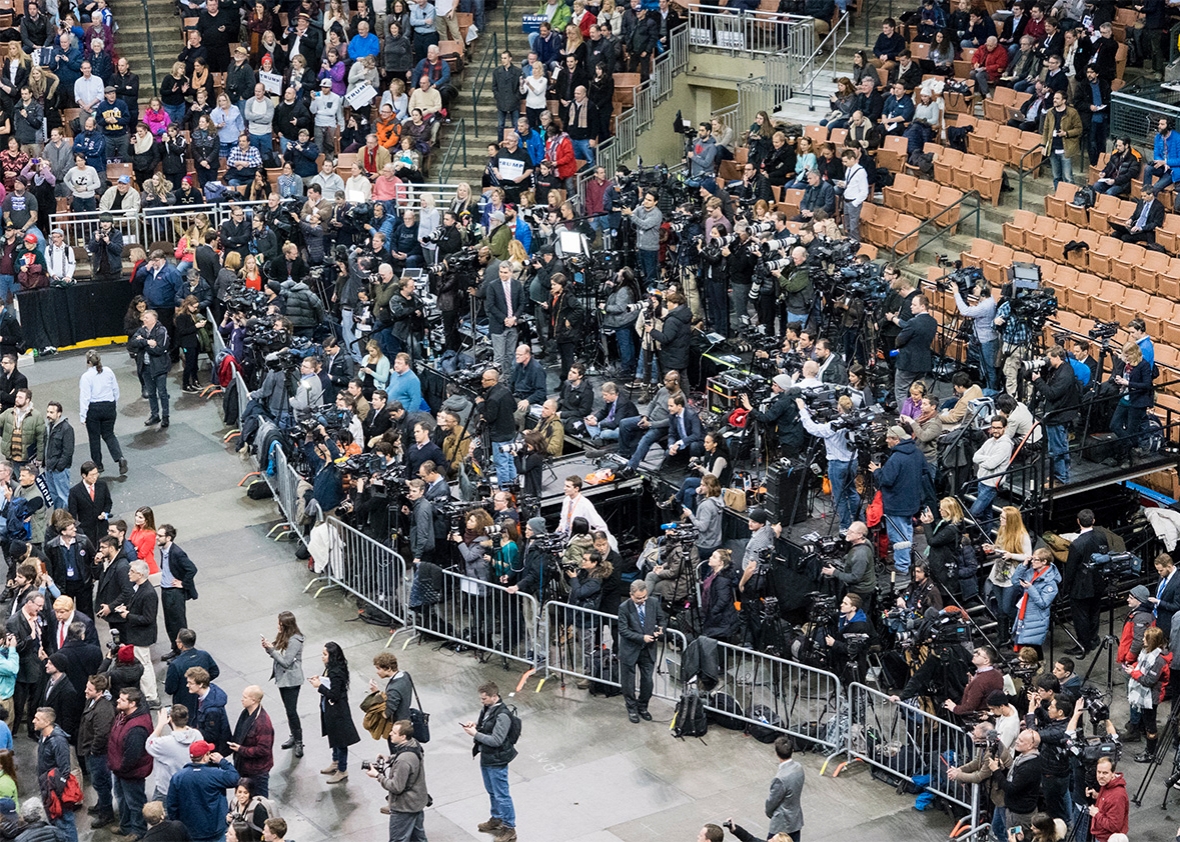
Peter van Agtmael/Magnum Photos
On March 11, an hour before the scheduled start of a Donald Trump rally in Chicago, I checked into the venue’s media pen—a rectangle of metal bike racks corralling the press—and introduced myself to a few of the journalists there. I was talking to Sopan Deb, a CBS News reporter who’s been following the Trump campaign for months, when the first protest erupted in the crowd. Trump supporters had encircled some guys wearing “Muslims United Against Donald Trump” T-shirts. Deb excused himself, hoisted his video camera onto his shoulder, and sprinted out of the pen for a better angle on the hubbub.
When he returned, he set down his camera and resumed chatting with me as though nothing had happened. A newspaper writer sidled over to join our pleasant conversation. Within a minute or two, another protester was yelling. My new pals swiveled their heads, quickly pinpointed the disturbance, and raced back into the crowd.
Was this the normal gig? “Totally normal,” said Deb, safely in the pen once more, unfazed by the brewing rancor. “People think it’s new, but this has been going on at Trump rallies since at least November. There’ll be 10 more of those tonight.”
As the planned start time for the event drew near, a pair of men with Trump pins on the lapels of their suits sealed the media pen’s exit. “They’re not allowed to leave anymore,” I overheard one suit instruct the other. “Not until he”—the “he” being Trump—“has left the building.”
The flare-ups continued and intensified. Police swarmed into the stands. Everyone was on their feet, shouting and pointing. When a PA announcement informed us that the event had been canceled, the place detonated.
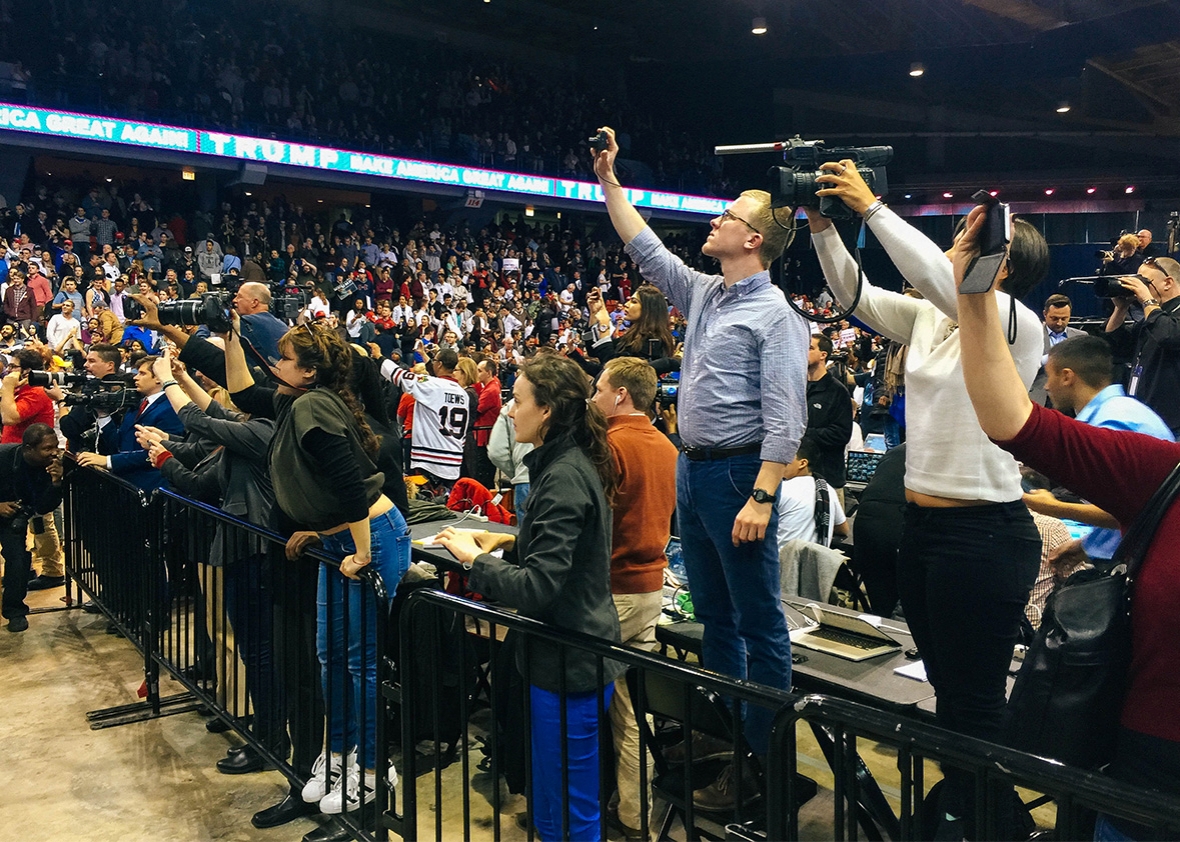
Seth Stevenson
Reporters scurried to edges of the media pen, still hemmed in, and leaned their cameras over the barricades. Realizing this was folly, they soon mounted a jailbreak. I followed them and found myself amid a churning mob on the arena floor—scuffles everywhere, people shrieking at each other, ripping signs from hands, knocking hats from heads, shoving, stumbling. The cameras raced from one brawl to the next.
When the bedlam flowed outside, I went to a spot where protesters were screaming at people trying to exit the parking garage in their cars. Trump supporters on the garage’s upper levels were jeering at the protesters below, throwing popcorn. “Oh, you’re gonna spit on us now?” said an angry protester, looking up into what did appear to be a hail of expectoration. I saw a newspaper reporter I’d just met inside wading into the fray with her notebook in hand, trying to gather quotes.
The next morning, scanning news about the rally, I learned that Deb—while attempting to film the ruckus in the streets—had been thrown to the ground by Chicago cops, handcuffed, arrested, and detained in jail.*
* * *
Jeb Bush rallies were not like this. Covering a Jeb event meant freely mingling with 40 people sitting calmly on folding chairs. Covering a Trump event is like watching a 1970s Black Flag concert from inside a shark cage.
What’s it like to be on the Trump beat all the time? To have enlisted for the noble civic duty of election reportage, only to find yourself smack at the center of tinderbox crowds and pro-wrestling atmospherics? Is it tough to endure the troubling, media-bashing behavior of the Trump campaign itself?
I followed the circus from Chicago to Cleveland and then down to Florida for a series of rallies, hanging out with Trump’s press pack along the way to find out. When they weren’t busy darting from one skirmish to the next, several Trump reporters (who spoke anonymously because they were not willing or permitted by their news organizations to go on the record) described their experiences out on the trail.
The first thing they all said about Trump’s press operation was that “there is no Trump press operation.” There’s just Hope Hicks, a twentysomething former Ralph Lauren model who’s never previously worked in politics. She functions more like a celebrity PR shop than a political communications team. And she remains a remote figure. On other campaigns, the press operatives develop chummy relationships with the press corps. “There’s no collegiality,” said one reporter. “No one’s getting dinner with Hope.”
While Hicks writes up the emails and press releases, Trump is his own media strategist. And in some ways he’s the most accessible candidate of all—as long as you’re a TV host like CNN’s Don Lemon or MSNBC’s Joe Scarborough. But there’s no behind-the-scenes information coming from his campaign, no one else but Trump (and occasionally his campaign manager) to talk to. Where other candidates might have a dozen aides a journalist can develop as sources, along with donors and pollsters and ad-makers who’ll leak inside scoop, with Trump there’s none of that. Maybe you get some state-level operatives on the phone, but it doesn’t matter because they never know anything. “You don’t get sourced up like you normally would,” one reporter told me. “It all happens on the surface. You just try to interpret it.”
Asking policy questions is like throwing a rock down a bottomless well. “If I have a question about women’s issues, or Hispanic issues,” said one reporter, “it’s not like they point me to specific press liaisons who handle those. There aren’t any such people.” Most policy queries simply go unanswered. When a response does come back, it’s rarely sufficient. “There’s no point anyway,” said another reporter. “You might get a response to a question about immigration policy, but the next day on TV, Trump will contradict it.”
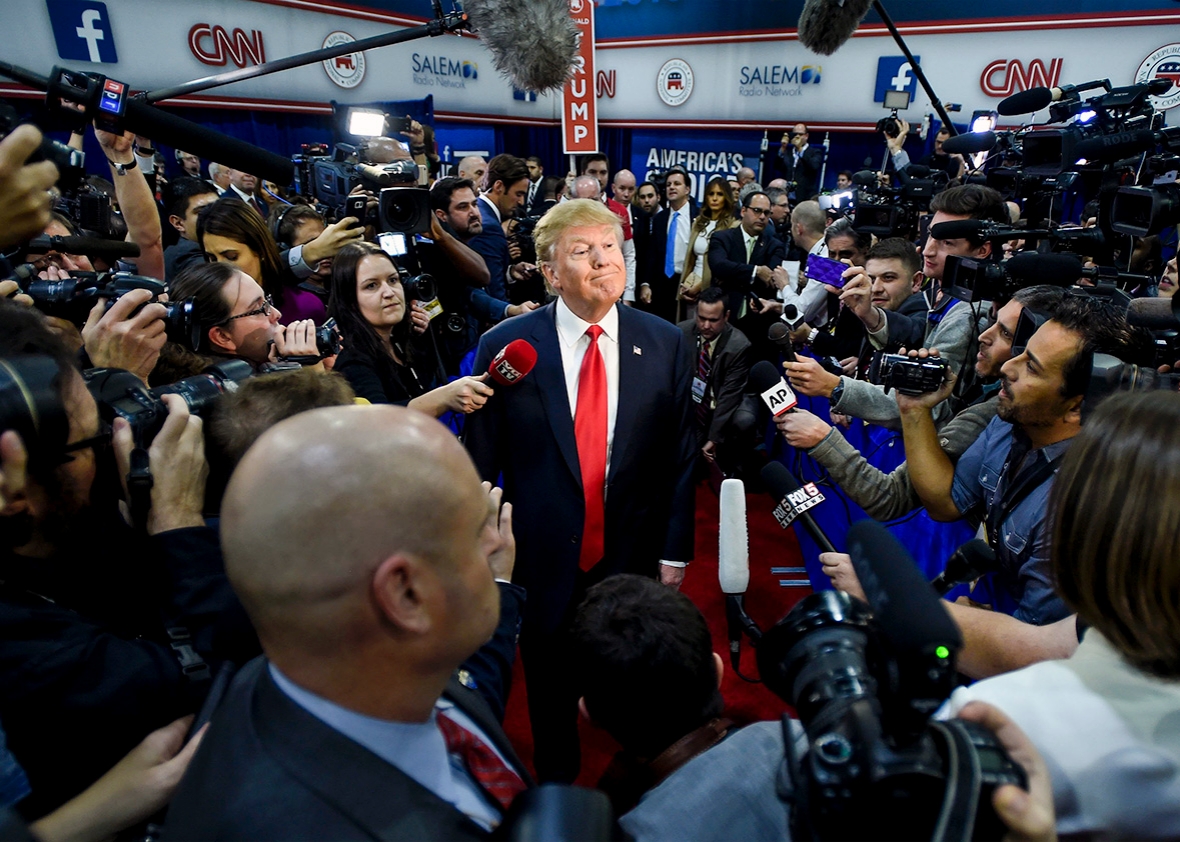
Riccardo Savi/AP
And of course there are the lies. Politico Magazine tallied more than 60 in a week of Trump appearances. At a rally in Boca Raton, Florida, on March 13, I heard him utter at least two bald untruths in the first two minutes of his speech (he said there were 25,000 people at his Chicago rally when the arena holds fewer than 10,000, and then he repeated the falsehood that no one had been injured at the event). But journalists I talked to who continue to report the lies as such don’t feel their efforts have much effect. “How many times can you write that the same statement is untrue?” mused one reporter. “At some point, the lie stops being news.” And debunking a claim doesn’t stop Trump from making it again.
The hokum washes over you after a while. A reporter sitting next to me at the Saturday rally in Cleveland chuckled when Trump bragged there were 29,000 people in the room. “That can’t be remotely possible,” she said, lifting her head for a moment to assess the crowd, then giving up and returning her gaze to her laptop. A fire marshal later announced the attendance had been about 7,000. The lie, though, never made it into her piece. Why bother to spend the time and column space to correct a silly exaggeration, when this same man has said he might want to summarily execute enemy combatants and defile their bodies? You need to pick your battles.
“We used to fact-check everything, every day,” another reporter told me, “but it gets hard to keep up.” For a writer filing on deadline an hour after a rally ends, there’s not enough time to thoroughly fact-check the dozens of fabrications that spilled from the stage. It’s also hard to know who the fact-checking is for. At this point, anyone who hates Trump has ample evidence he’s a liar. And anyone who loves Trump doesn’t care.
* * *
The more time I spent with the Trump press pack, the more sympathy I had for them. They display equanimity in the face of outrageous behavior. They display physical courage in the face of near rumbles. Perhaps I’m a fragile soul—Trump would no doubt come up with a snappy epithet to encapsulate my wuss-itude—but I’m not sure that I could handle the emotional rigors of their workplace.
The Thunderdome vibe at Trump events set my teeth on edge. Each time the mood tautened, I’d wonder: Is this the day a truly tragic thing happens? I found it unsettling that the loudest cheers at these rallies—the moments when the crowd would unleash pure glee and actual fist pumps—came when Trump would direct his security team to eject a protester by shouting, “OK, get him out!” The press isn’t allowed to exit or enter the designated pen while the rallies are happening, which means you can either stay inside to get separation from the crowds (and a usable workspace) or stay outside to get close-up footage of altercations happening amid the throngs (unless, as in the case of a Sun-Sentinel reporter, you’re threatened with arrest for doing so).
I also could not abide large, repeated doses of in-person Trump. It infuriated me when he’d pause between telling blatant whoppers to point at the media pen and say, “Those are very dishonest people, I have to tell you.” On cue, his minions would spin around and boo us.
Sometimes, he gets personal with the press. At one rally, Trump referred to NBC News reporter Katy Tur as “little Katy, third-rate journalist” while she was in the pen, surrounded by his riled-up groupies. In February, Tur tweeted about another special moment on the trail:
Trump trashes press. Crowd jeers. Guy by press 'pen' looks at us & screams "you're a bitch!" Other gentleman gives cameras the double bird.
— Katy Tur (@KatyTurNBC) February 21, 2016
“Sometimes we get tense,” another journalist told me. “I’m surprised there hasn’t been an incident of someone throwing a blunt object and hitting a reporter in the head. I wouldn’t be shocked if it happened.”
The longtime Trump embeds are a close-knit group. They gossip and commiserate. After Deb’s arrest, there was a flurry of texts coordinating ways to help, checking on the latest updates. They have to remind themselves not to get inured to their surroundings. Things that a year ago might have seemed monumentally loony, or off-the-charts unacceptable, now barely raise an eyebrow. “I think we need troop rotations for the embedded reporters,” suggested one writer. “You need a fresh set of eyes to say, ‘I can’t believe what I just saw.’ ”
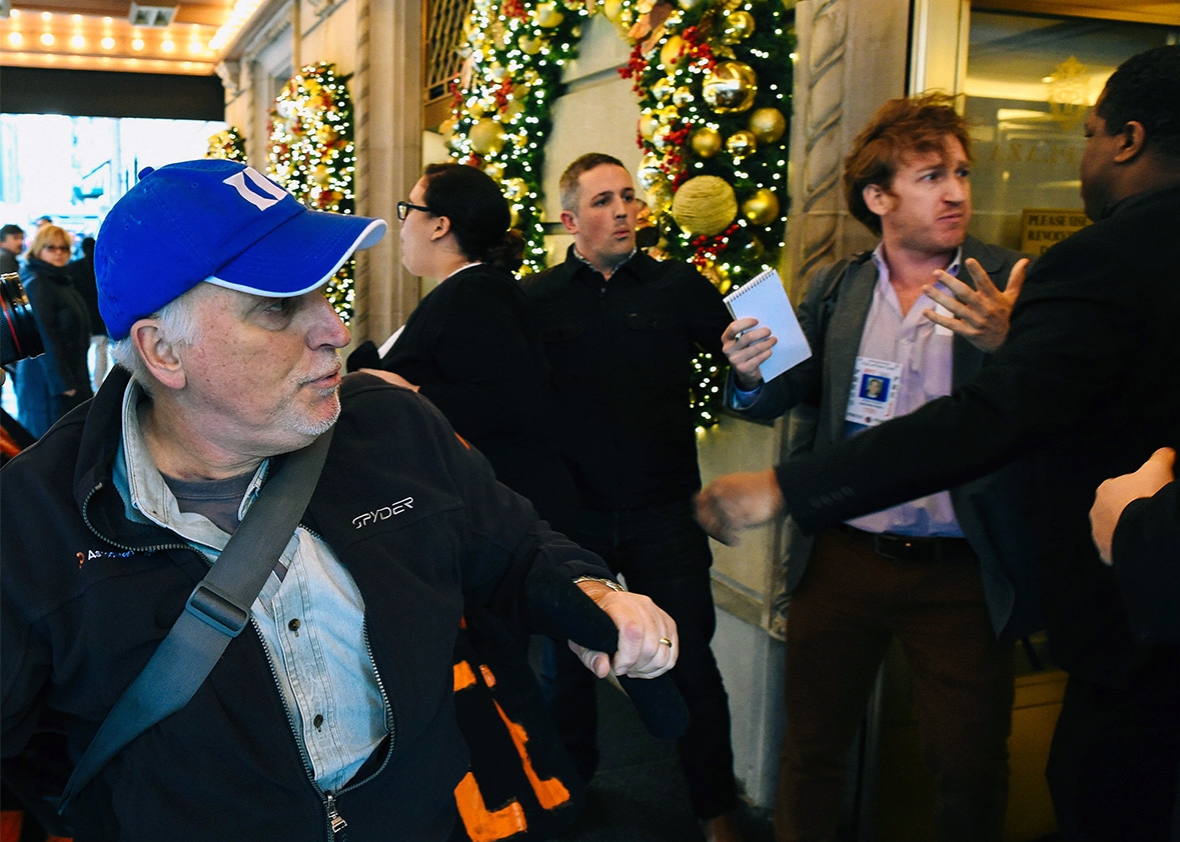
Timothy A. Clary/AFP/Getty Images
Despite the heavy adjectives getting thrown around—fascist, demagogue, authoritarian—the beat reporters I spoke to mostly felt they couldn’t use that kind of language. Opinion writers, sure. But straight news journalists felt the best they could do was catalog the madness and let the American citizenry decide. Some writers objected to the idea that they were giving Trump too much coverage—after all, he’s the GOP front-runner, and this campaign is something we’ve never seen before. At least one writer did, however, feel the situation was different when it comes to cable news, where Trump’s thirst for airtime and the networks’ thirst for ratings can profoundly skew the calculus.
As the Trump campaign has accrued power, its treatment of the media has grown ever more worrisome. Reporters told me that Trump is incredibly attuned to his coverage in a way that other presidential candidates aren’t. The campaign will sometimes single out specific outlets for vindictive treatment. The Des Moines Register, the New York Times, BuzzFeed, and Univision were all denied access to Trump events in the wake of running negative coverage. Both the National Press Club and the White House Correspondents’ Association have already felt compelled to fire their first meek shots over Trump’s bow.
Trump’s campaign manager, former New Hampshire state police officer Corey Lewandowski, was recently accused of physically accosting a female Breitbart reporter. Whatever the severity of the manhandling, the campaign’s response in the aftermath has been, to use a favorite Trump word, “disgusting.” Despite photographic evidence and an immediate eyewitness report from a trustworthy Washington Post writer, the campaign continues to deny that the incident ever happened. Hicks attacked the Breitbart reporter’s integrity, releasing a statement including this line: “We leave to others whether this is part of a larger pattern of exaggerating incidents, but on multiple occasions she has become part of the news story as opposed to reporting it.” Lewandowski tweeted that the Breitbart reporter was “delusional.” There’s no shame, no accountability, no decency. “Trump surrounds himself with a bunch of dicks,” shrugged one writer, referring to Lewandowski, and other reporters I spoke to tended to agree. On Saturday, Lewandowski was again caught getting rough on camera, this time with a protester in Arizona, and again the campaign denied it despite visual evidence.
A couple of journalists on the Trump beat were already beginning to express concern about how the media might fare under a Trump presidency, if he should win. The previous two presidents have been imperfect in their treatment of the press—both Bush and Obama closed ranks and tightened access in ways that previous administrations hadn’t—but basic norms pertained. Would Trump honor quaint traditions regarding White House press coverage? No one knows. “It’s occurring to me that it’s a really fucking slippery slope,” said one reporter. “I’ve been assuming the White House Correspondents’ Association would negotiate for traditional access and protocols. But I’m applying a rational schema to this. What’s to prevent Donald Trump from just getting rid of the WHCA? Trump doesn’t let the press pack on his plane now, something that other candidates all do. Would President Trump let reporters on Air Force One?”
Campaigns can provide a window into how an administration will be run. The vast machinery of American governance might in many ways keep an outlandish President Trump in check. But there’s not much to prevent Trump’s White House press shop from resembling his press shop now: capricious, inscrutable, vindictive, insulated. I’m imagining President Trump communicating solely via tweets and phone-ins to cable news shows. I’m imagining the New York Times—a paper that Trump says “allows dishonest reporters to totally fabricate stories”—getting barred on a whim from the White House briefing room. I’m imagining journalists emailing policy questions to press secretary Hope Hicks and receiving no response. (Hicks did not respond to emailed questions for this story.)
* * *
On Tuesday night, as the primary returns rolled in, reporters flocked to the luxurious confines of Mar-a-Lago, Trump’s personal residence in Palm Beach, Florida. Some of us had dressed more formally than out on the trail, to match the surroundings. The balmy, scented air wafted over us as we strolled across the lawns and proceeded through the Secret Service security check at the door. Once inside, we mingled beneath the gaudy chandeliers of the enormous Donald J. Trump Ballroom, waiting for the man to appear.
As we were enjoying Mr. Trump’s hospitality, another reporter was being turned away at the Mar-a-Lago gates. Politico writer Ben Schreckinger had been previously approved for credentials, only to have them revoked after he wrote a negative piece about Lewandowski. He was told to leave the grounds. Later that evening, Trump would call Schreckinger “a dishonest, third-rate reporter with a failing outlet that will soon be out of business, hopefully.”
Sopan Deb had made it past the door. He was sporting a new abrasion beneath his chin, where he’d made contact with Chicago pavement four days before. The police would later drop the charges against him, and he seemed to be taking the whole thing in stride. But getting arrested wasn’t even the first unfortunate personal incident Deb had endured while on the Trump trail. At a January rally in Reno, Nevada, a Trump supporter asked Deb if he was taking pictures for ISIS (adding, “Yeah, I’m talking to you” when Deb looked at him in shock). I asked him if, given the unique nature of this campaign and his experiences covering it, he feels any special responsibility to raise alarms in his work. “All I can do is my job,” he said. “Whether my reporting makes any difference is out of my control.”
Trump had taken questions from the press during his previous election night celebrations at Mar-a-Lago. The first time, a reporter told me, he’d seated his rich friends and Mar-a-Lago Club members in the front two rows and put the press behind them. The next time, Trump’s friends had been given the front seven rows, pushing the press farther back. But Tuesday night, as Trump basked in victory, there were a full 16 rows of rich pals—500 or so elegantly dressed Palm Beach dandies—banishing reporters to the rear of the ballroom, about 40 yards away from Trump’s podium.
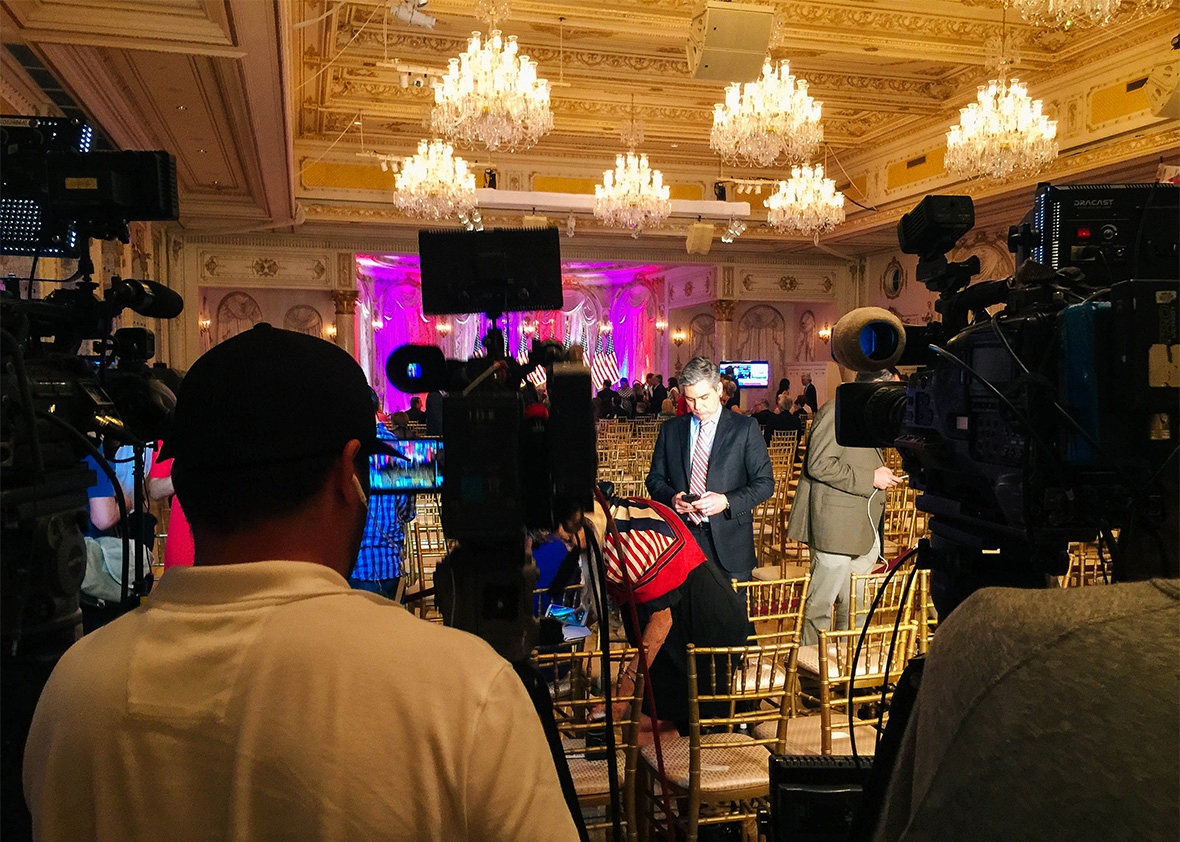
Seth Stevenson
I asked my press pack friends how they were going to ask him questions from this distance. They weren’t sure. They guessed they might be given microphones. One print reporter assured me she had a really big voice.
It turned out not to matter. Though the event had been labeled a “press conference,” and we’d all obtained credentials on that basis, Trump gave a short speech—Lewandowski grinning at his side—called reporters “disgusting,” and then exited the room without fielding a single question. My friend with the big voice shouted, “This is supposed to be a press conference! Aren’t you going to talk to us?!”
We could hear her loud and clear. But Trump strolled past without acknowledging her. If you want a picture of a future Trump presidency, imagine a reporter shouting questions into an empty void.
*Correction, March 21, 2016: This piece originally misstated that reporter Sopan Deb had been detained in jail overnight. He was detained for several hours, but not overnight. (Return.)
